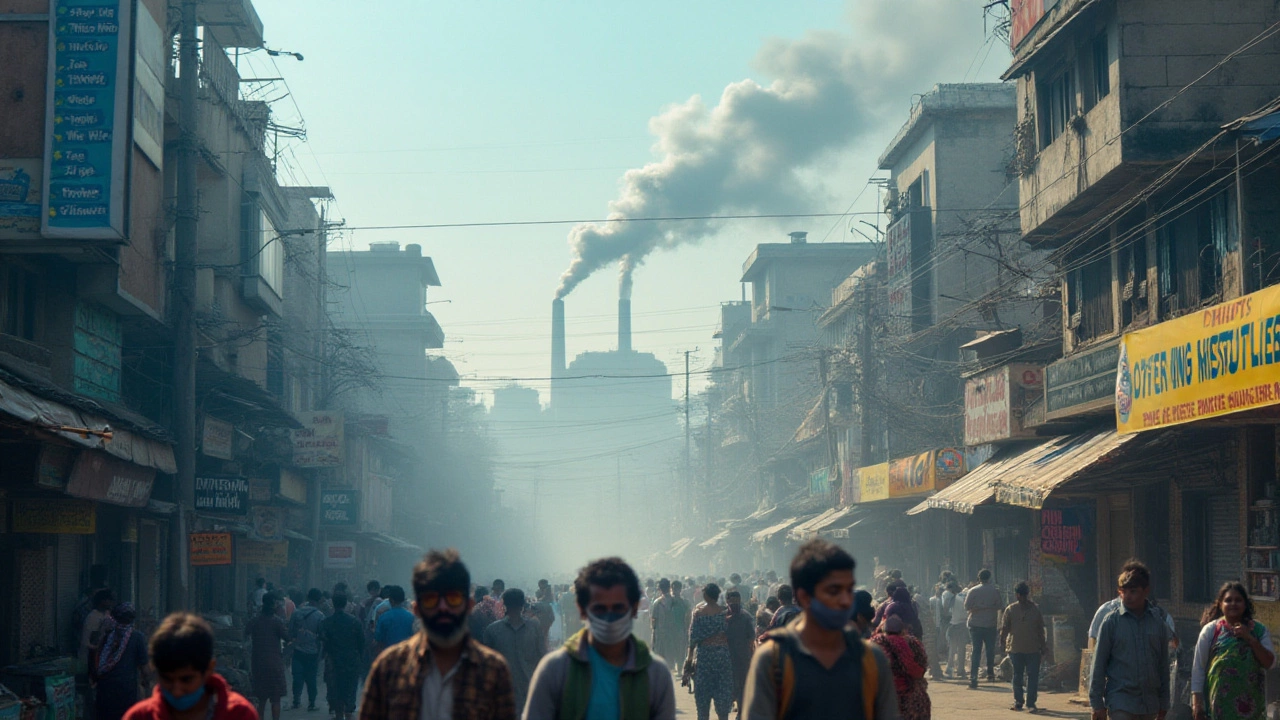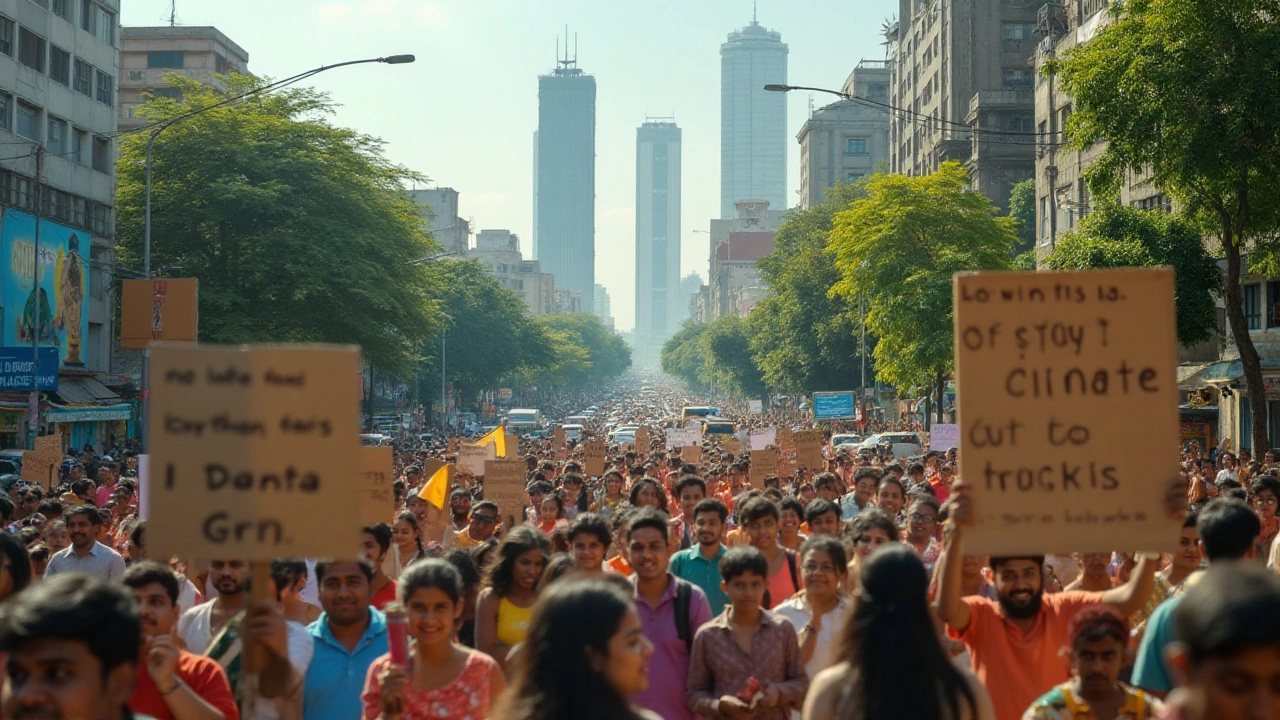Top 3 Pressing Environmental Issues of 2025: Understanding Climate Challenges
 Jan, 12 2025
Jan, 12 2025
Our planet is teeming with life and diversity, yet it's also facing an unprecedented upheaval. With every passing year, the demands for environmental action become ever more pressing. It's now 2025, and the call to understand and tackle the leading environmental issues is stronger than ever.
Three major culprits loom large on the environmental horizon: the relentless rise of climate change, the insidious spread of pollution, and the rampant scale of deforestation. Each presents its own challenges, yet they are entwined in a web affecting not just nature but our everyday lives too.
- The Claw of Climate Change
- Pollution's Pernicious Spread
- Deforestation's Destruction
- Steps Toward Sustainable Solutions
The Claw of Climate Change
Climate change is not just a buzzword thrown around by activists; it's a stark reality that's shaping our world at an alarming rate. This shift in our climate encompasses significant changes in global temperatures, resulting from increased concentrations of greenhouse gases in the atmosphere. From Cape Town to Beijing, no corner of the planet is immune to its effects. With the melting of the polar ice caps, we face rising sea levels that threaten coastal communities worldwide. What were once rare weather events, like hurricanes and typhoons, are becoming increasingly common and deadlier, leaving behind a trail of devastation in their path.
The science is unequivocal. According to the Intergovernmental Panel on Climate Change (IPCC), we must restrict global warming to 1.5 degrees Celsius above pre-industrial levels to avert catastrophic consequences. Yet, statistics remind us that global carbon dioxide concentrations reached 419 parts per million in 2023—numbers not seen in millions of years. The threat extends beyond natural disasters; it infiltrates agriculture, altering growing seasons and reducing yields, which in turn affects food security on a global scale. This dramatic shift pushes many species to the brink as they struggle to adapt to rapidly changing habitats.
In the process of investigating ways to counteract or at least stabilize the effects of climate change, some interesting and innovative solutions have emerged. Renewable energy sources like solar, wind, and hydroelectric power offer viable alternatives to traditional fossil fuels. Subsidizing these renewable solutions can lower costs and encourage widespread adoption. Governments worldwide are slowly recognizing the urgency to pivot from coal and oil. A dedicated effort towards these alternatives is crucial if we're to curb the escalation of global temperatures.
Public perception and participation also play an essential role. Many feel overwhelmed by the scale of the problem, often unsure how they can make a meaningful impact. Individual efforts might seem inconsequential, but collectively, they become a living testament to the power of community and resolve. Simple practices such as reducing meat consumption, opting for carpooling, and being judicious about energy consumption can bring about profound positive changes over time.
"Humanity faces a stark choice: business as usual or a major change in the direction of development. Attitude, especially among young people, is critical," says Dr. Jane Goodall, wildlife researcher and conservationist.
Indeed, climate change remains a multifaceted issue. It is not just about weather patterns but a comprehensive transformation that forces us to rethink infrastructure, economy, and lifestyle choices. As daunting as it may appear, the opportunity for meaningful action and change is still within our grasp. Together, these efforts can help us mitigate the 'claw' of climate change as it cinches tighter around our planet, presenting opportunities for smarter, more sustainable practices in everyday life.

Pollution's Pernicious Spread
As we move through 2025, the specter of pollution continues to cast a long shadow over our natural world. Pollution is not a new issue, but its scale and impact have grown alarmingly, affecting both the rich and the poor nations alike. From bustling cities to the remotest of areas, the traces of human impact are evident. Air pollution alone is a silent, invisible enemy that claims millions of lives globally every year. According to the World Health Organization, nine out of ten people breathe air with high levels of pollutants, a stark testament to its omnipresence.
There are different facets to this colossal issue. One area often highlighted is the marine pollution thought to originate largely from land-based activities. It's estimated that about 80% of ocean pollution stems from human-initiated actions on land. This pervasive influx of waste and chemicals into our oceans leads to devastation on marine ecosystems, rendering some underwater habitats barely recognizable. The public holiday favorite, plastics, is among the most aggressive pollutants, killing marine life and disrupting biodiversity on unprecedented levels. The Great Pacific Garbage Patch, a floating collection of plastic in the ocean, spans an area twice the size of Texas, a chilling testament to pollution’s reach.
Unlike other environmental challenges, pollution stands out due to its far-reaching health implications. In urban environments, vehicular emissions and industrial discharges release significant volumes of pollutants into the air, risking respiratory ailments and other diseases in local populations. Consider the staggering statistic that nearly 7 million people died in 2022 due to exposure to air pollution. Besides, pollution doesn’t respect boundaries; it often disperses beyond points of origin, affecting regions far and wide, crossing borders with ease.
Yet notable steps are being taken in the war against this formidable foe. Numerous global agreements, local policies, and community movements focus on reducing pollution. Consider China, a country historically associated with smog-filled skies, now championing clean energy initiatives. Solar and wind sources are gradually replacing coal and other outdated power sources. Similar shifts are visible in countries like Denmark, where renewable energy powers substantial portions of the nation.
"Our oceans and rivers are the bloodstream of our planet. Yet, we are filling it with poison," warned UN environment chief Inger Andersen during a pivotal environmental summit.
As pollution tightens its grasp, public awareness and education are pivotal to fighting its spread. Encouraging responsible disposal of waste, regulatory controls on emissions, and technological advancements in waste management are all essential tools. Recycling, once a buzzword, now becomes a lifestyle that everyone must embrace. Strong governance, community engagement, and international cooperation play vital roles in tackling the pollution pandemic. Efforts to curb this menace demand creativity and resilience, but they hold the promise of cleaner, healthier futures for generations ahead.

Deforestation's Destruction
In an ever-evolving world where natural resources are heavily tapped to fuel economic growth, the vast stretches of forests that once enveloped our planet are dwindling. This rampant deforestation is not just a story about vanished trees but a tale of deep-seated repercussions that ripple through ecosystems and human societies. The scathing truth is that we are losing forests at a rate of about ten million hectares each year, an area roughly the size of South Korea. The reasons behind this rapid deforestation are myriad, from land being cleared for agriculture and urban expansion to logging and infrastructure development. These actions strip the planet of its green cover, which acts as Earth's lungs, and their absence leads to a catastrophic imbalance in the atmosphere.
Forests play a crucial role in the carbon cycle, as they absorb significant amounts of CO2 from the atmosphere, serving as carbon sinks that mitigate the effects of climate change. When trees are felled, not only is this crucial carbon-absorbing facility lost, but the carbon stored in these trees is also released back into the atmosphere, exacerbating the greenhouse effect. The ramifications extend beyond just climatic disruptions. Thousands of species call these forests home, and with deforestation comes habitat destruction, pushing many species towards extinction. In fact, it is estimated that around 80% of Earth's terrestrial animals and plants live in these habitats.
The social and cultural impacts of deforestation are equally profound. Many indigenous communities rely directly on forests for their livelihoods, shelter, medicine, and cultural practices. As these forests disappear, so does their heritage and way of life. Professor Wangari Maathai, who won the Nobel Peace Prize for her environmental work, once said,
“The environment and the economy are really both two sides of the same coin. If we cannot sustain the environment, we cannot sustain ourselves.”Her words ring particularly true in the context of deforestation, highlighting the intertwined fate of human and environmental well-being.
Efforts to combat deforestation must be multi-faceted and robust. Protecting existing forests is a start but not enough. We must also engage in reforestation and afforestation, planting trees in barren and unsustainable landscapes. Governments and individuals alike can play a part in reducing the demand for deforested materials by promoting sustainable products and responsible consumer behavior. Encouragingly, technological advancements are providing new ways to monitor tree cover loss with greater accuracy, allowing for targeted conservation efforts.
Impact on Biodiversity and Climate
The effects of deforestation extend far beyond environmental degradation. It's a ticking time bomb for pollution levels too. As forests diminish, the buffer that reduces pollution by filtering particulates and absorbing gases diminishes as well. As a consequence, air and water quality deteriorate, affecting ecosystems and human health. Furthermore, the soil, once held tightly by the roots of the trees, becomes prone to erosion which leads to infertility and desertification, creating harsh landscapes where lush forests once stood. It's an ecological domino effect, one that takes a gargantuan effort to reverse but a mere shrug of neglect to set in motion.

Steps Toward Sustainable Solutions
The challenges posed by climate change, pollution, and deforestation are daunting, yet they are not insurmountable. The first step toward crafting a more sustainable future is rooted in education and awareness. By understanding the intricate relations between human activities and environmental degradation, communities can empower themselves to enact meaningful change. Start by integrating climate change education within school curriculums, as well as community workshops focused on sustainable practices. Knowledge sparks action, setting the stage for responsible decision-making that prioritizes long-term ecological health over short-term gains.
Transitioning to a more environmentally friendly lifestyle involves revisiting everyday choices. Ensuring that pollution levels are cut down requires a collective effort in reducing waste. Encouraging the adoption of reusable products and promoting recycling initiatives within localities can have a significant impact on reducing the plastic and chemical collecting in our oceans and landfills. Governments and corporations too have a part to play by adopting stricter pollution control regulations and investing in clean technologies. Think electric vehicles and renewable energy platforms like wind, solar, and hybrid systems. Studies have shown that increasing renewable energy use by just 2% annually could negate billions of tons of emissions within a decade.
"We do not inherit the Earth from our ancestors, we borrow it from our children." - A famous wisdom often attributed to Native American Proverb that highlights our responsibility to future generations.
The preservation of forests, essential to mitigating climate change, involves understanding the role of deforestation in the disruption of ecosystems and biodiversity. This requires action from both grassroots initiatives and multi-national policies. Options include supporting reforestation projects and eco-certification programs aimed at promoting sustainable forestry practices where logging takes place. Deforestation hotspots, which contribute significantly to emissions when forests are burned or felled, must be targeted through global cooperation and enforcement to halt illegal logging.
Making tangible steps toward sustainable solutions not only relies on policy and innovation but also on instilling a culture of environmental stewardship. Encouraging community involvement through volunteer tree-planting events or educational campaigns can foster a collective mindset committed to combating the top environmental issues. To support these ongoing efforts, it is vital for donations and funding to consistently reach non-profits and other environmental NGOs, which tirelessly work on the ground to effect positive global change. Every single effort counts, and the sum of small actions can lead to large-scale shifts toward sustainability.
Finally, a change in personal consumption, alongside shifts in agricultural practices toward sustainable methods, can contribute immensely. Embracing a plant-based diet or reducing meat consumption can cut down greenhouse gases, as meat production is a significant source of emissions. Agricultural practices like crop rotation and polyculture can enhance soil health and reduce the need for harmful pesticides and fertilizers. Together, these conscious choices complement larger systemic changes, paving a path to a balanced coexistence with nature for both current and future generations.